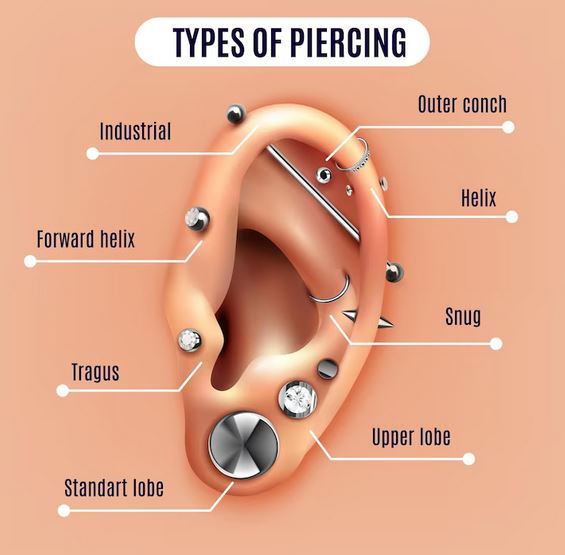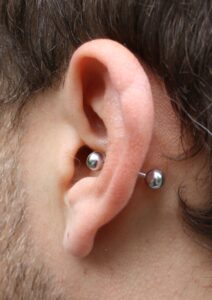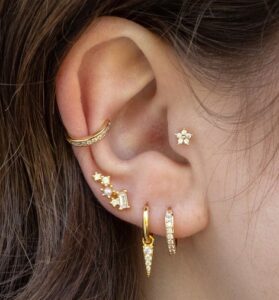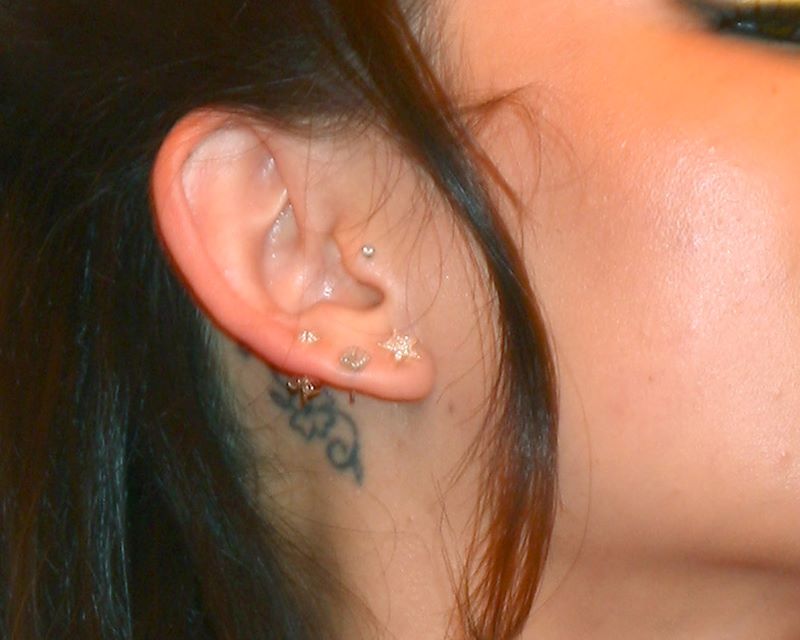Did you know that the jewelry industry is worth an estimated $308 billion? When you consider the unique looks possible with things like earrings, this shouldn’t come as a big surprise. Now, when most people think of earring piercings, they tend to picture the standard lobe placement. While there’s nothing wrong with the classics, it’s important to remember that there’s a whole other world of earring placement out there. If you’re ready for a new piercing, but aren’t sure where to get it, you’re in the perfect place. Read on as we walk you through everything you need to know about this important fashion topic in our earring placement guide.

Helix Piercings
Helix piercings run the gauntlet around the outside of the ear lobe. It starts its way at the top with the forward helix and can work its way down to the mid helix, or auricle.
Because there’s so much flexibility with the placement, helix piercings tend to be one of the first ones to go after the standard lobe placement. It’s common to have two to three small pieces running down the various sections of the helix.
Larger, one-piece earrings can sometimes run the entire length of the helix. Make sure to check out this link if you want to find skull earrings that curl all around the length of the helix. It’s a bold fashion statement.
Upper Lobe Piercings
The upper lobe is another good step for second or third earring placement. Your lobe has a lot of space to work with, so it can handle multiple piercings further up. Many sets of two or three earrings will often complement these upper lobe piercings.
This is also a great option for people that like larger, dangling styles of piercings. Best of all, like the standard lobe, it’s fairly low on the pain scale. Just keep in mind that the higher up on your lobe you go, the longer it will take to heal.
Conch Piercings

Conch piercings, which get their name from the iconic shell, are located directly in the middle section of your ear cartilage. Typically the only earrings you can use in this area are studs.
However, some people have been known to put on cuffs as well. Just keep in mind that this tends to be a pretty subtle piercing. So if you want an attention-grabbing piece, it’s probably not the best area.
Feeling brave? Consider a piercing toward the inner conch. This is the closest your piercing can get to the ear canal.
Because it’s the thickest part of your cartilage, you can expect it to take a while to heal fully.
Industrial Piercings

A favorite of alternative styles everywhere, the industrial earring jewelry piercing is a straight barbell piece. First, it goes through cartilage in the mid-ear before running out a second time in the upper ear.
Industrial piercings look great, but there’s an important caveat that comes with them. Keep in mind that they take a long time to heal.
Because the piercing goes through two sections of cartilage, it’s not uncommon for it to take a full year before being healed. Also, it’s not the best option if you have long, messy hair or glasses. These can both get in the way.
Daith Piercings
The daith is found on a connecting piece of cartilage that runs through the top of your inner ear. It’s an extremely common place for a simple hooped ring.
Some people even suggest that this type of piercing can potentially have some medicinal benefits, like helping with pain tolerance. Just make sure you get a skilled piercer to do it.
The daith piercing can be quite challenging even for professionals, so make sure they have some experience before you proceed.
Tragus Piercings

You know the tiny little flap that’s covering your ear canal? That’s known as the tragus. This is the perfect piercing location for an attractive stud. However, it belongs as part of a curated ear.
So it might not be the best second or third piercing you get. Just keep in mind that your tragus will likely take six to nine months to heal.
During that time, you won’t be able to wear earbuds. So if you rely on these for your commute or work, you might want to think twice about getting a tragus piercing.
Snug Piercings
The snug piercing is also referred to as the anti-helix. That’s because it goes through the inner part of the cartilage that’s opposite of the helix. It snugs into the fold of your skin with either a small hoop or a tiny barbell.
This type of piercing certainly looks great. However, be warned. It’s by far one of the most painful types of earrings. So if you don’t have a high tolerance for discomfort, consider a different piercing placement.
Rook Piercings
A rook piercing is certainly one of the more unusual locations out there. It’s found directly above the daith. Then, it’s wedged between the helix and the inner conch.
If you want an attractive hoop in your inner ear, this is a good location. However, while the piercing heals, it’s recommended to keep a bar inside of it.
Appreciate Learning About Earring Placement? Keep Exploring

We hope this guide helped you learn more about earring placement. After learning about the different places you can get ears pierced, it can be tempting to get multiple new ones.
However, we recommend getting them one at a time. This gives you time to time to find earrings that you like with that placement and consider which new piercing placements might complement them.
If you’re looking for more fashion advice, you’re in the perfect place. We have plenty of similar style topics that you can find by exploring our website in more detail.
